2017 Yamaha FZ-10 First Ride Review

Yamaha's not messing around with its new streetfighter
One of the most hotly contested categories in motorcycling today, the liter-class streetfighter field has a contender from nearly every manufacturer out there. But if you’ve read the numerous streetfighter reviews posted on Motorcycle.com and other outlets, you’ll know that three models – super streetfighters, if you will – stand above the rest: the BMW S1000R, Aprilia Tuono V4 1100, and KTM Super Duke R.
2017 Yamaha FZ-10
| Engine | 19.0/20 |
| Suspension/Handling | 13.0/15 |
| Transmission/Clutch | 9.0/10 |
| Brakes | 8.0/10 |
| Instruments/Controls | 4.0/5 |
| Ergonomics/Comfort | 8.5/10 |
| Appearance/Quality | 9.0/10 |
| Desirability | 9.0/10 |
| Value | 9.0/10 |
| Overall Score | 88.5/100 |
Well, it’s time to add a fourth bike to the conversation: the 2017 Yamaha FZ-10.
More than just an R1 stripped down, the FZ-10 has all the elements that make the three European bikes above so special: striking looks, real-world comfort, and most importantly, mind-blowing performance. As an added bonus, the FZ’s $12,999 price tag is also highly competitive, besting the $14,799 Tuono V4 RR, $13,495 S1000R, and $16,999 Super Duke R.
Which leads us to the heart of the matter: the FZ-10’s 998cc Crossplane-crankshaft four-cylinder engine borrowed directly from the R1, with a few tweaks to make it better suited for the street. The idea here was to give the FZ more torque on the bottom and mid-range compared to the R1. To do that, the cylinder head sees new designs for the intake ports and combustion chamber. The FZ also gets new forged aluminum pistons. Together, these changes result in compression ratio dropping a point compared to the R1 from 13.0:1 to 12.0:1.
But the changes don’t end there. Smaller intake valves (31mm vs 33mm) compared to the R1 are now steel instead of titanium, the airbox is two liters larger (12L vs. 10L), and the FZ ditches the R1’s dual injectors for single injectors producing 25% more volume per pulse. The FZ also sees new intake and exhaust cams with reduced lift and duration compared to the R1, again to promote torque over horsepower. Other changes include a new crankshaft with a higher moment of inertia (marketing speak for heavier) to help reduce sudden movements due to jerky throttle inputs, steel connecting rods, and a reduction in diameter of the titanium muffler’s inner core, from 54mm to 42.6mm. Lastly, the FZ sees a new throttle body, needed to incorporate perhaps one of my favorite features on a streetbike: cruise control!
Generally, when the words “retuned for torque” are spoken about an engine, reactions vary from moans to sighs. Horsepower numbers are great for bragging rights, but when it comes to street riding, torque is what you want and the earlier you can get it the better. With that in mind, chew on this for a second: Yamaha claims that with the changes made to the FZ-10 engine, it makes 18% more torque in the midrange (at 7000 rpm, to be exact, looking at Yamaha’s dyno chart) and matches the R1’s peak torque number of 81.9 lb-ft at 9000 rpm. Internal gear ratios haven’t changed compared to the R1, but final-drive gearing is 5% lower.
After the engine, more changes were made in the electronics department as the FZ doesn’t feature the IMU seen in the R1. Despite this, the FZ still gets ABS and four-stage traction control (three levels plus off), easily toggled between with a thumb switch on the left bar. ABS comes standard and the front and rear brakes are not linked. Technically it isn’t switchable, but as with other bikes we’ve tested, turning off TC and performing a burnout (or dyno pull) is a backdoor method to disabling ABS.
The FZ-10 retains the YCC-T-enabled drive modes seen on other Yamahas, but things get confusing as Yamaha has changed their meaning for reasons even Yamaha staff on hand couldn’t answer. The three modes – A, B, and Standard – all remain, only now B is the most aggressive setting, A is the middle setting, and Standard is the most benign. In the past A was most aggressive, Standard was the middle setting, and B was the softest. If this is the only bike you’ll own then it’s not very hard to get used to, but for owners of other recent Yamahas (or motojournalists in this case) who ride different models, it could take a while to adapt. Full power is still delivered no matter which mode you’re in, but the rate of butterfly opening is what changes in each mode.
Frame and chassis are largely the same between the R1 and FZ, though the FZ’s subframe is steel instead of magnesium to better accommodate luggage and a passenger. The FZ shares the same frame and KYB suspension as the R1, but the latter’s damping rates have been recalibrated for street use rather than track duty. Other minor differences include a steel fuel tank instead of the aluminum one on the R1, slightly lower pegs, and an LCD screen instead of the R1’s TFT display. While not as colorful as the TFT, the LCD screen is large and easy to read. The digital speedo reading dominates the display and is surrounded by a bar graph tach, fuel gauge, temperature reading (ambient and coolant), odometer and tripmeters, and ride modes, traction control and gear-position indicators. Not to mention the array of idiot lights on either side.
Two nods to the FZ’s street versatility are the addition of cruise control and a 12-volt outlet located behind the headlights. The controls for the cruise control are identical to that seen on the FJR1300 sport-tourer and operate in fourth through sixth gears, starting at 30 mph all the way to 112 mph. The power outlet is useful to keep GPS devices charged or to power heated clothing on colder rides. While not specifically aimed towards the sport-touring crowd, Yamaha wouldn’t rule out the FZ-10 should your long-distance riding lean more towards the sporty side of the touring spectrum. And with the addition of Yamaha’s accessory windscreen, top case and saddlebags developed for the FZ, setting the cruise control and burning away the miles isn’t out of the question.
So How Does It Ride Already?
But enough with the specs and touring fluff. You want to know how the FZ is to ride. To find out, Yamaha invited journalists to the (in)famous Tail of the Dragon on the Tennessee/North Carolina border. Otherwise known as US-129, 318 turns are packed into this 11-mile stretch of road packs and is one of the most well known sport riding roads in the country, if not the world.
To say the FZ was in its element would be an understatement. The revised engine is an absolute ripper, its bump in mid-range torque instantly noticeable in this real-world riding environment. No matter the ride mode, once the revs are anywhere near the 7,000 mark, a whack of the throttle and a tug on the bars will bring the front end in the air. I’ll be the first to admit I stink at wheelies, but even I was able to hoist dank whoolies even in third gear. No clutch required.
The engine unsurprisingly signs off near its 12,200 rpm redline, but with its fat torque curve you’ll want to shift before then anyway. Despite the fact it’s not equipped with a quickshifter, if you didn’t need to breathe the throttle to upshift, you’d never know. Gear changes in either direction, but especially up, are like my favorite summer beer: smooth, light, and crisp. As far as the ride modes go, B mode, the most aggressive, is still far too twitchy for my taste. The A mode is a little more manageable, but for 80% of the ride I kept it in Standard, switching over if I wanted to wheelie out of every corner instead of just every other one.
Of course all of this is ignoring the biggest reason you’d want to constantly rev the R1: that sound! The exhaust note that Crossplane crank belts out is wonderfully intoxicating, and for those moments when it was bouncing off the hills and through the trees of the North Carolina landscape, it was like being in my own little slice of heaven. Without a doubt, in terms of both power, sound and fun factor, I’d line up the FZ-10 engine against the likes of the Super Duke R, S1000R, and Tuono V4. It’s definitely on par with the Europeans and a step above the other Japanese contenders.
On the handling front, the FZ-10 shares the same 24.0º rake and 102mm trail as the R1, but wheelbase is slightly shorter (55.1 in. vs. 55.3 in.). I sure as heck couldn’t tell you if the FZ’s shorter wheelbase helps it turn any faster than the R1 without riding them back-to-back, but what I can tell you is that the FZ is pleasantly light on its feet. At a claimed 463 lbs. wet, the FZ is lighter than the Super Duke (470 lbs.) and Tuono (469 lbs.), but just slightly heavier than the S1000R (450 lbs.). Regardless, its agility seems on par with the European super streetfighters. The bars are just the right width in my opinion; wide enough to give good leverage, but not overly so. Bridgestone Battlax Hypersport S20 tires were specially developed for the bike. A 120/70-17 sits in front, with a 190/55-17 in the rear.
I was especially impressed with the Yamaha’s KYB suspension. Both ends are fully adjustable for preload, rebound, and compression damping, with the shock also featuring adjustable circuits for both high- and low-speed compression. While not top-shelf Ohlins or WP units, the KYB stuff easily soaked up the bumps on the Dragon’s Tail while minimally upsetting the chassis. Even mid-corner, the FZ would simply absorb the hit and continue on its arc. Admittedly, “bumps” on the well maintained Tail of the Dragon are nothing like some of the huge ripples in other parts of the country, so a true test of the suspension will have to wait. While not necessarily a negative, the FZ’s overall damping feels softer than what I remember from the KTM and the Aprilia.
Apart from the confusing ride modes, the FZ’s biggest downfall is its brakes. The hardware is all there, with dual 320mm discs clamped by Advics radial-mounted four-piston calipers fed via a Brembo radial master cylinder, but the hoses are rubber and ultimately brake lever feel is a little soft. Overall braking power is never in question though, I just wish I could have a little more feedback at the lever.
Our ride also included a short highway stint, where the FZ proved to be a pleasant everyday bike as well. The rider triangle is obviously much more upright compared to the R1, with the bars 42.2 inches from the ground compared to 32.0 inches on the R1. Pegs are also lower: 13.6 inches to the tarmac versus 15.9 inches on the R and slightly more forward too. The seat is broad in its rearward section, tapering towards the front with decent padding, though Iron Butters will probably want to opt for the accessory seat option. At these lower speeds I also noticed a fair amount of engine heat radiating to my legs. It didn’t reach Ducati Panigale levels, but it was definitely noticeable.
Time for another shootout
The first time I rode the current generation Yamaha YZF-R1 on the street, I throttled out of my driveway and by the time I rolled to the stop sign at the corner, I hated the bike. The bars were low, the pegs high, and the seat was thinly padded. To make matters worse, after a few more miles it was obvious the engine was tuned for the high-speed confines of the racetrack. It seemed bored with the more mundane pace of the real world.
The FZ-10 changes all of that. It’s comfortable for the everyday roles of a streetbike, has all the performance you want on the street, and to me, has the looks to back it up. Styling is clearly a subjective issue, but the polarizing anime-inspired design of the FZ definitely looks better in person than in pictures.
I’m stopping short of making any predictions on how the Yamaha would stack up against the other three super streetfighters, but I’m confident it’ll hold its own. This clearly means we’ll have to get the quartet together to see how they shake out. Excited? You should be.
2017 Yamaha FZ-10
+ Highs
- That sound!
- Excellent mid-range torque
- Cruise control
– Sighs
- Brake lever a little soft
- Excess engine heat
- Ride modes are really confusing
2017 Yamaha FZ-10 Specifications | ||
|---|---|---|
| Price | $12,999 | |
| Engine | Liquid-cooled, DOHC, 16-valves (4-valves/cyl), inline four-cylinder | |
| Displacement | 998cc | |
| Bore and Stroke | 79 x 50.9 mm | |
| Compression Ratio | 12:1 | |
| Fuel Delivery | Fuel injection with YCC-T | |
| Ignition | TCI: Transistor Controlled Ignition | |
| Transmission | 6-speed; wet multiplate assist-and-slipper clutch | |
| Final Drive | Chain | |
| Front Suspension | 43mm KYB inverted fork, fully adjustable; 4.7- in travel | |
| Rear Suspension | KYB single shock w/piggyback reservoir, fully adjustable; 4.7-in travel | |
| Front Brakes | Dual hydraulic disc, 320mm; ABS | |
| Rear Brakes | Hydraulic disc, 220mm; ABS | |
| Front Tires | 120/70ZR17 | |
| Rear Tires | 190/55ZR17 | |
| L x W x H | 82.5 in. x 31.5 in. x 43.7 in. | |
| Seat Height | 32.5 in. | |
| Wheelbase | 55.1 in. | |
| Rake | 24° | |
| Trail | 4.0 in. | |
| Ground Clearance | 5.1 in. | |
| Fuel Capacity | 4.5 US gallons | |
| Wet Weight (Claimed) | 463 lb. | |
| Warranty | 1 Year (Limited Factory Warranty) | |
| Colors | Armor Gray; Matte Raven Black | |

Troy's been riding motorcycles and writing about them since 2006, getting his start at Rider Magazine. From there, he moved to Sport Rider Magazine before finally landing at Motorcycle.com in 2011. A lifelong gearhead who didn't fully immerse himself in motorcycles until his teenage years, Troy's interests have always been in technology, performance, and going fast. Naturally, racing was the perfect avenue to combine all three. Troy has been racing nearly as long as he's been riding and has competed at the AMA national level. He's also won multiple club races throughout the country, culminating in a Utah Sport Bike Association championship in 2011. He has been invited as a guest instructor for the Yamaha Champions Riding School, and when he's not out riding, he's either wrenching on bikes or watching MotoGP.
More by Troy Siahaan



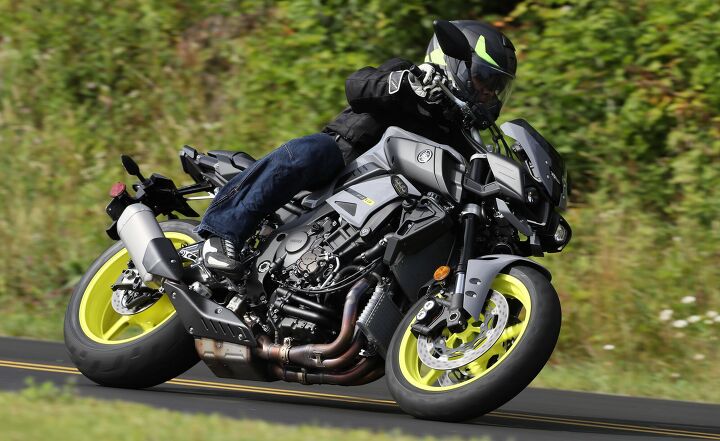
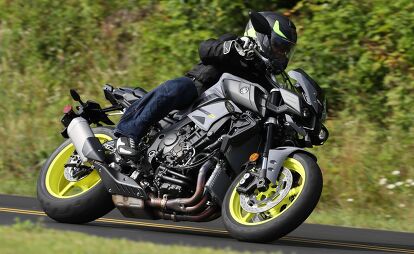





















































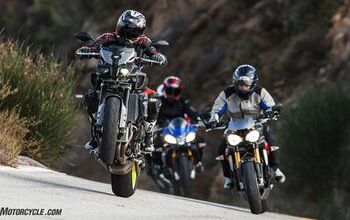

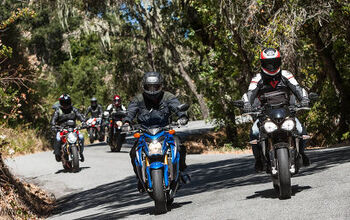
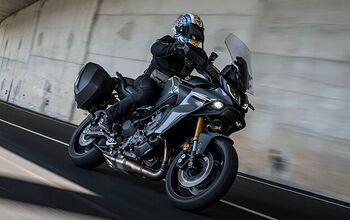
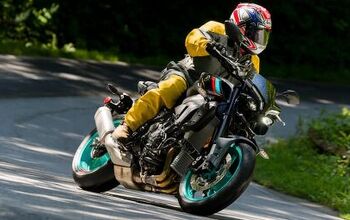













Comments
Join the conversation
Remember when Forester Whitaker found Manny in Platoon with a sign around his neck.And Sgt. Barnes looks Angry and says,"Dem Muther Fuckers."Thats how I feel when we don't get all the cool home market Japanese stuff like Quickshifters.And the most modern cool or retro cool motorcycles,In Japan a 250cc to 400 cc motorcycle is enough because of the narrow roads and traffic.You have to split lanes everywhere.I had a friend with a original 1969 CB 750 four that he rode me around on in the summer of 84 and we split lanes everywhere but it was a lil too big and sometimes my knees would hit the car bumpers a little bit.I would have to tuck in.If I had a 2017 Yamaha FZ09 in Japan with all that torque and nimbleness.I would be king of FUJI Mountain and the roads of Tokyo and Yokohama.I want to go to Japan and purchase a 2017 FZ09 and blast around meeting girls and hanging out and ripping up the streets.
Its BTW the FZ10,the 2018 Suzuki GSX-S1000F ABS,or the 2017 or 18 Ducati Supersport S.I will test ride all 3 before I purchase the right motorcycle for me.The Suzuki has a lot of HP.The Ducati.Not so much HP.The FZ10 is in the middle of HP.I like that the Ducati has a up/down quickshifter.